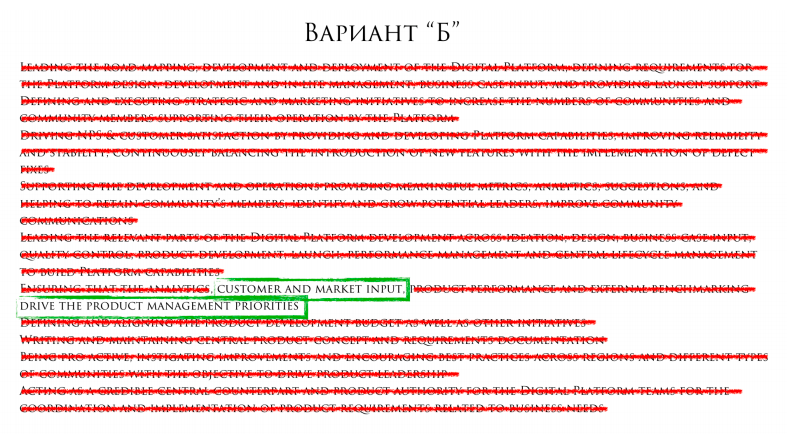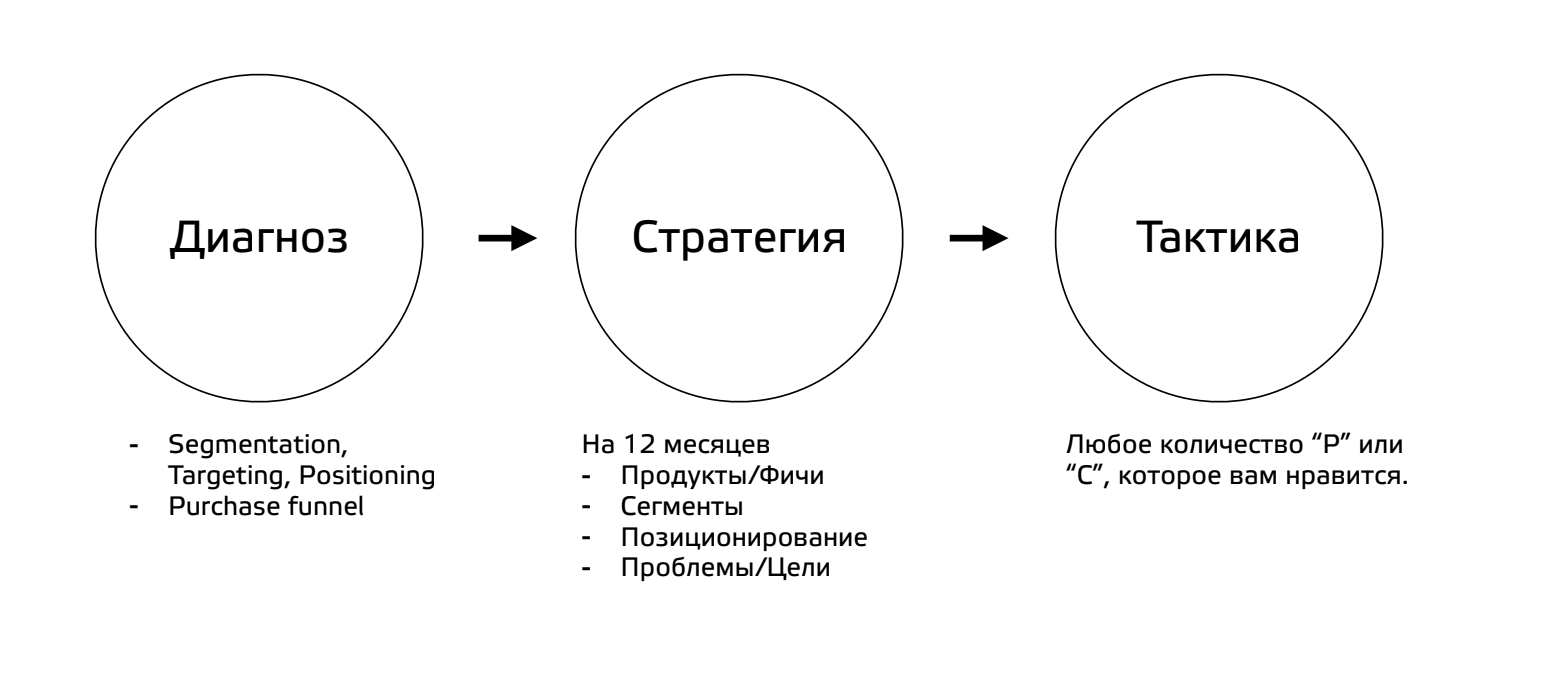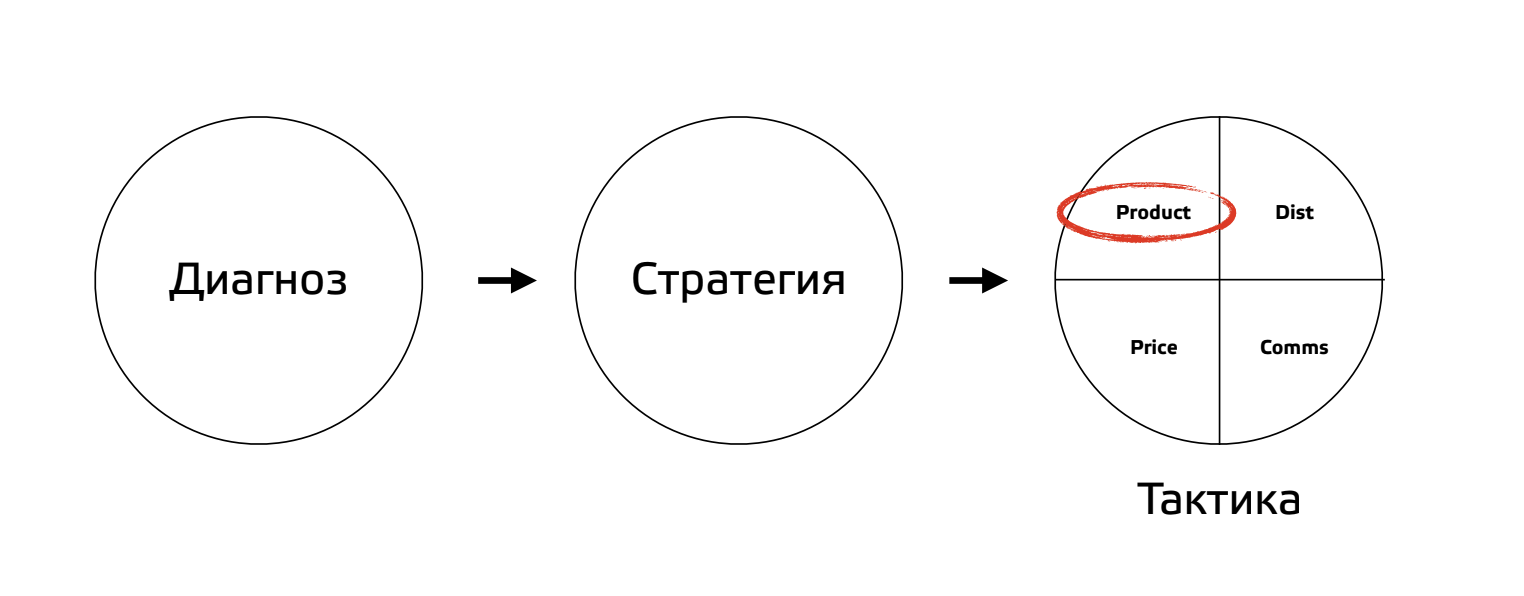What a Product Manager Should Actually Do
Yargolk Rush from Wargaming told who the employers are actually looking for, how the product manager differs from the producer, and by what framework he works.The problem with most product conferences is that report topics have nothing to do with product management. Speakers talk about metrics, trendy frameworks, OKR and KPI, but not about what a product manager should actually do. Let's try to figure out why this happened.Yaropolk Rush at ProductSense Conference
Who the employers are actually looking for
Employers communicate their ideas about product management to the market through job descriptions. If you read the vacancies of "product managers", it becomes clear that most employers do not need them at all. For example, Wargaming and EPAM announcements are vacancies about everything except product management: Wargaming - 10 words on the topic of
Wargaming - 10 words on the topic of
 EPAM
EPAM
product management - half of the paragraph is related to product management.These companies are looking for producers. The producer is a worthy profession and has long existed in the fields of entertainment, cinema and music. The problem is that it has nothing to do with product management.A producer is a person who does what is said for money and uses the resources that are. He doesn’t care what will happen to these resources later if we talk about people. So, Les Grossman in Soldiers of Failure is the archetype of a true producer. It is also important that the producer can put the light on, sit behind the camera or the console of the mixer. He knows the craft is often no worse than the performers. In general, a producer is such a PM on steroids. I will be happy if most of the product managers are renamed as producers, because it will be true.Our typical product manager does not really know how to code, but really wants to, so he found a place near the developers and crawls to them. Because of this, I will soon cease to call myself a product manager, because it will be indecent to present myself like this, especially among real businessmen. "Product Manager" for them is an incomprehensible role with a vague meaning, but these are customers of our work.The main task of the product manager
So who is a product manager? Almost every one of you at school had a person who realized that you had pocket money to buy school breakfasts, and realized that there are things that are not for sale in the school cafeteria, but you would rather buy them than breakfast. Let's say these are chocolates. The person who combined potential demand in the mind, the ability to realize value in the right place and sell it with 800% markup is the psychotype of a product manager.The primary task of the product manager is to describe the conditions under which profit can be made in the short, medium or long term. Not new cool features and not landing page traffic, but the conditions under which it is possible to make a profit in a variant convenient for your company.The product manager determines the target segments, their needs and the conditions under which they must be satisfied. Sometimes it is impossible to make a profit until the product satisfies the needs of several segments: for example, for content creators to come to you, it is also necessary for content consumers to come to you.The task of the product here is to realize the conditions in which the desired segments will be drawn to the product, and to determine the feasibility of such a scenario. In general, if you are a product manager, I have bad news - you do not create any objects, do not manage development, do not synchronize functions and do not delve into metrics.
In general, if you are a product manager, I have bad news - you do not create any objects, do not manage development, do not synchronize functions and do not delve into metrics.The product manager describes the conditions under which profit can be made.
Our product manager, figuratively speaking, got out of the window of a moving car, clings to his heels and tries to get into the next car to tell the developer who is trying to close the window: “Dude, you're doing everything wrong. This is the rounding of the buttons that will be perfect. ” Do not do this, this is not your job. Your job is to describe the conditions under which profit is possible.Manage product, not development
The product manager controls the product, the project manager controls the development team. So that you’ll not be considered a project manager all your life, but considered a product, you need to deal with product management. The product is managed by a framework known to everyone since the days of Noah and his ark: Audience. They forget about it because they believe that the target audience is 100% of people connected to the Internet. It is not right.If we say that the target audience of the game is console players who prefer competitive gameplay, there will be a lot of questions. Who is it, how and where to look for them? Do they play sports simulations or session shooters?The meaning of segmentation is to describe a segment that is monolithic internally in terms of relationships, preferences, etc. Social network takes the last place - it matters only in special cases.Sales funnel. If you are working with a product, you will have to understand how to work with a sales funnel. Bad news again - the funnel starts not on the landing page, but much earlier. Many product managers and entire companies ignore all stages of the funnel, except at the time of the purchase and, paradoxically, lose sales.
Audience. They forget about it because they believe that the target audience is 100% of people connected to the Internet. It is not right.If we say that the target audience of the game is console players who prefer competitive gameplay, there will be a lot of questions. Who is it, how and where to look for them? Do they play sports simulations or session shooters?The meaning of segmentation is to describe a segment that is monolithic internally in terms of relationships, preferences, etc. Social network takes the last place - it matters only in special cases.Sales funnel. If you are working with a product, you will have to understand how to work with a sales funnel. Bad news again - the funnel starts not on the landing page, but much earlier. Many product managers and entire companies ignore all stages of the funnel, except at the time of the purchase and, paradoxically, lose sales. Sales Funnel
Sales Funnel
Strategy. The principles have not changed since people realized that you can draw a map, show where the enemies are on it, and draw an arrow: if they are waiting on the left, we will bypass them on the right.A strategy does not make sense if it is written for more than a year. Those who ask for plans for three or five years know this and do not expect the truth, starting from the 13th month. They are aware that in six months or the first 12 months you will come and say: "There are clarifications."For more than a year, the strategy is drug addiction that has nothing to do with reality.
If you are a product director, then in the strategy you define the products with which you interact. If the product manager is features with which you will interact for the first year. Also determine the audience segments with which you plan to work, and your positioning against these segments. From this you derive problems or goals. In a year it is realistic to fulfill three goals, the fourth - optional, in a jump.Tactics. Any number of P (Product, Price, Promotion, Place) or C (Customer, Competition, Company) that you like. Read more about this in the article .Diagnosis, strategy and tactics
Neither “research” nor “analysis” leads to action. When you come to the doctor, you don’t want him to “investigate” and “do the tests,” but you want him to say that he will heal. Red is what we most often see, and green is what we want.
Red is what we most often see, and green is what we want.
If the product knows what to "treat", it becomes clear whether it makes sense to do this or if you need to do other things. But more often than not, we start managing products from the wrong side — not from defining a problem, but from choosing solutions.Personally, the classic four Ps are enough for me in tactics: If you are only involved in product changes, you, as a product manager, are not even good at cat food. You are unsuitable, because Product is 8% of product management, the remaining 92% you missed. This is called featureism, and many products suffer from it.Many of us have witnessed situations when a product manager knocks on a table at a meeting with stakeholders: “Well, guys, let's speak the language of business.” At this point, you can see - stakeholders turn away so as not to neigh. The fact is that a person who considers himself a product manager begins to juggle metrics: ROI, ARPU, CTR. Further, the meeting will either end quickly, or the stakeholder will cling to one of the abbreviations and pose the stupid task to the product. The product takes a peak and rejoices as he pressed this stakeholder with data.
If you are only involved in product changes, you, as a product manager, are not even good at cat food. You are unsuitable, because Product is 8% of product management, the remaining 92% you missed. This is called featureism, and many products suffer from it.Many of us have witnessed situations when a product manager knocks on a table at a meeting with stakeholders: “Well, guys, let's speak the language of business.” At this point, you can see - stakeholders turn away so as not to neigh. The fact is that a person who considers himself a product manager begins to juggle metrics: ROI, ARPU, CTR. Further, the meeting will either end quickly, or the stakeholder will cling to one of the abbreviations and pose the stupid task to the product. The product takes a peak and rejoices as he pressed this stakeholder with data.Metrics themselves mean nothing.
Metrics are not the language of business, metrics are sensitive molecules on the tentacles that grow from non-obvious places in your business. The language of business is a diagnosis, strategy, tactics or problem, plan, solution.How to work on the framework
If you are a product manager, you understand that a bunch of diagnosis, strategy and tactics is your framework. If you are a good product manager, you understand its nuances.Sequential movement. From one stage to the next you move sequentially - like on rails on a railway.For example, you make a diagnosis, move to a strategy, screw up a strategy - return to the diagnosis. We worked with the diagnosis - we switched to strategy, the strategy developed - we switched to tactics, tactics do not stick, it’s too expensive, we return to the strategy. In general, move back and forth along these rails until everything is lined up.Equal effort. If you have a project that took half a year to develop, then with a high probability you spent a year on diagnosing and choosing a strategy.The system is multiplicative. The stages of the framework (diagnosis, strategy, tactics) are factors. If you missed or ruined the stage, you get zero in the multiplier, everything flies you know where.Quality control. As a good product manager, you should manage the quality of the diagnosis, strategy and tactics, and not watch how the analyst stores the data or how the code is written. Suppose we evaluate quality on a scale of 1 to 10. Nobody wants to spend 18 months of life to make 1 x 1 x 1. It is unlikely that anyone does 10 out of 10, so strive for at least 8 x 8 x 8. Product -management is the art of managing the quality of elements of a product framework.Market orientation that no one does
Do not confuse market orientation with customer development. The meaning of the first is that you do not know anything about the product until you ask the user. Customer development is one of dozens of methods for qualitative analysis. It, like any qualitative research, does not work without quantitative analysis and vice versa.The essence of Market Orientation is that you are the least qualified person to have an opinion on your product because you are biased. Thus, your opinion is not only stupid, but also dangerous.Quantitative and qualitative studies are done together. Without high-quality, you will ask the wrong questions and come up with the wrong answers, and without the quantitative, you will make the product for the focus group, and not for the user.Work with the audience.Judging by the job descriptions, from 6 to 8% of the product manager's activity is to go and ask the audience what she needs. In reality, everything is worse - you have no time.If you do not focus on the market, stupid things happen to you: Here is the first example of mistakes made by non-market-oriented marketers and product managers. There are two lists in the picture:
Here is the first example of mistakes made by non-market-oriented marketers and product managers. There are two lists in the picture:- The first is the communication channels that the audience selects, preferring certain categories of goods.
- The second is the communication channels that marketers choose to promote these product categories.
What’s in the top of the audience’s perceptions is in the * priorities of the marketers.Or, let's say you are writing a document about brand purpose, which will tell people how their life will change and they will become what they are not. When you write, you represent Elon Musk because you want to be like him. And, judging by the data of the Ministry of Labor, the ultimate dream of Russian users is the captain of an ocean-going vessel. As a result, you will write a communication strategy not for your audience, but for yourself.
As a result, you will write a communication strategy not for your audience, but for yourself.
What to pay attention to the product manager
The Subtle Art of Not Giving a F * ck says that there are things you want to spend your attention on and things you don't want to. At the same time, attention is limited to "piecewise" - in the English version it is f * cks to give. These f * cks are usually no more than ten.If you have ten resources, then eight is worth spending to figure out for which audience and what needs to be done to make money appear there. The remaining two should be spent on finding the answer, which project will you do when this does not work out. We all live in an iterative world, but we believe that the product manager is a superhero. Whatever product he gives him, with the help of superpower he will change reality so that it becomes suitable for a worthless product. And he does it instead of looking for Product / Market Fit and trying options.But you must mentally prepare for failure, as the inevitable companion of the iterative process. The product did not work out - it doesn’t matter, they wrote off it and move on to the next one. This is the guarantee of mental health for a person who is forced to engage in product management. Product management is a serial enterprise: you try, try, try. You’re trying not to disperse the blood, but to find a Product / Market Fit.findings
- Product manager - a rare mindset, not massive.
- Decide who you really want to be - a product manager or producer.
- The primary task of the product manager is to describe the conditions under which profit can be made.
- A product controls a product, not product development and not inventing features.
- The product is managed by the framework: diagnosis → strategy → tactics.
- Metrics are not the language of business, but the ability to make a diagnosis and evaluate the result. The language of business is a diagnosis + strategy + tactics.
- Accept the concept of market orientation, use qualitative and quantitative research in conjunction.
- 20% of the time, think about which product you will deal with if this one does not take off.
Watch the full performance of Yaropolk Rush at the ProductSense conference. ProductSense Product ManagementConference is one of the projects of the ProductSense team . We make transcripts of reports from our conferences and write articles on them. Thank you for preparing the article by Asya Man. Source: https://habr.com/ru/post/undefined/
All Articles